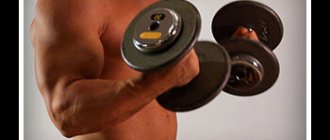Eat right
If you have at least once asked your trainer the question “How to quickly gain muscle mass?”, then in response you have definitely heard from him a long monologue about the benefits of proper nutrition. And believe me, the coaches know what they are talking about. To begin with, give up three meals a day. In your case, you need to eat more often - about once every two hours, but this, of course, does not mean that the portions should be huge. The main thing is more proteins and carbohydrates, but you will have to limit yourself very much in fats (you want to gain weight, not sides).
Get enough sleep - it's important
Getting enough sleep is important for overall health. Not getting enough rest at night and being chronically sleep deprived can have a negative impact on your physiological and cognitive function and is certainly not beneficial if you are trying to gain weight.10
During non-REM sleep (NREM)—when you're asleep but not dreaming—your body produces growth hormone. As the name suggests, this hormone is involved in tissue growth and repair. Additionally, NREM also releases anabolic (building) hormones, which prevent the breakdown of muscle proteins and help maintain muscle size.11
During the bulking period, you need to make sure that your muscles are exposed to a sufficient amount of growth hormone and anabolic hormones (for building muscle mass). You should spend enough time in the slow-wave sleep phase - at least seven hours a day.
Strengthen your legs
And, of course, you won’t be able to gain muscle mass without training. First, we advise you to take care of your feet. In the end, you need support for the pile of muscles that you want to build yourself. To do this, you will need classes on a step platform. We recommend trying the following exercise: stand on the machine with both feet and alternately lunge backwards with one leg. When lunging, it is very important to bend your knees. You shouldn't do this quickly, but 10-12 repetitions certainly won't take up too much time.
Rock your shoulders
We think that when you set out to gain weight, one of your main associations was broad shoulders. In addition to the fact that girls like it, it is also very useful during training. The stronger your shoulders, the more weight you can lift. To pump up your shoulders, exercise with a shock absorber. Take it in your hands, press your elbows to your body and pull the shock absorber in different directions so that your shoulder blades touch each other. In total, you should do 2-3 sets of 10-15 times per workout.
Training programs for gaining muscle mass at home
You can provoke muscle growth on your own - to do this, you should have a prepared training program for gaining weight. It is not necessary to work out in the gym - it is enough to have equipment in the form of additional weight.
Basic principles of home workout programs for gaining muscle mass:
- exercise no longer than one hour to avoid overwork, which negatively affects the building of muscle tissue;
- the duration of rest for each muscle group should not exceed three days;
- do basic exercises that allow you to pump up several groups at once;
- work with weights (free weights), as this is what affects the gain of muscle mass;
- not only increase the weight regularly, but also plan to make changes to the program, adding new tasks so that the body does not get used to it and does not lose the gained weight;
- Don't forget to warm up before each session to avoid straining.
Initially, aim for long-term work, because it is extremely difficult to gain weight quickly at home or in the gym. The increase in muscle tissue and weight gain occurs gradually and mainly due to the cumulative effect.
Full body workout for beginners
The most difficult thing for a beginner is to gain muscle mass. This is due to the fact that the body is not accustomed to stress, and the level of endurance and general body tone are low.
Don't try to gain muscle in a short period of time. If you overexert yourself, you will not be able to continue exercising in the coming days, which is bad for building muscle. Beginners should concentrate on their own sensations: a feeling of tension and discomfort in the muscles after a weight gain workout is normal, but you shouldn’t overdo it.
Chart for beginners
| Exercise name | Frequency |
| Warm-up | 3 minutes |
| Deep squats | 4 sets of 10 reps |
| Rest | 90 seconds |
| Lying dumbbell chest push-ups | 3 sets of 15 reps |
| Rest | 2 minutes |
| Upper pulley row to the pectoral muscles | 4 sets of 10 reps |
| Rest | 2 minutes |
| Triceps extensions with weights | 3 sets of 15 reps |
| Rest | 3 minutes |
| Seated dumbbell press | 4 sets of 10 reps |
| Rest | minute |
| Cool down by jogging on a treadmill | 10 minutes |
For maximum effect, alternate exercises for muscle mass daily, making your own adjustments. After a while, completely change your training plan to avoid addiction. This way you can quickly achieve your desired shape.
Program for intermediate level of training
When you begin to notice that exercises for gaining muscle mass have begun to produce results, and the level of load seems to have decreased with the old number of approaches, it’s time to move to a new level. Overcoming the “beginner” stage when it comes to pumping muscles at home is the most difficult stage. Now that your body is accustomed to regular exercise, you need to gradually increase the number of approaches and repetitions.
Aspects that indicate that gaining muscle mass at home should be taken to the next level:
- decline in productivity;
- lifting weights without effort;
- stopping or slowing muscle growth;
- calm heart rate and lack of muscle tension after training.
The advantages of training at home to gain muscle mass are that you can create a workout plan yourself and not waste time traveling to the gym. With the right level of awareness, self-control and discipline, you will achieve success just as quickly as with a coach.
| Exercise name | Frequency |
| Warm-up | 5 minutes |
| Bench press with barbell or dumbbells | 3 sets of 10 reps |
| Rest | 1 minute |
| Seated French press with dumbbells | 3 sets of 15 reps |
| Rest | 2 minutes |
| Lifting the barbell with the biceps area | 4 sets of 15 reps |
| Rest | 2 minutes |
| Deadlift | 4 sets of 10 reps |
| Rest | 1 minute |
| Deep squat with barbell | 3 sets of 15 reps |
| Rest | 2 minutes |
| Lateral raises with dumbbells | 3 sets of 10 reps |
| Cool down on the treadmill | 7-10 minutes |
Advanced program
In order to increase muscle mass, advanced athletes at home should pay attention to some nuances:
- Train to failure. If you lift the barbell 14 times, but you can’t do the 15th, the failure effect occurs. It is this that provokes an increase in muscle mass.
- During home workouts, drink plenty of clean water to rehydrate. You may need to drink significantly more than during previous exercise.
- To quickly gain muscle mass, pause between sets for a minute to a minute and a half.
Mass training should be done at a time that is comfortable for you: if you are more productive in the morning, then do it after breakfast, and if your peak activity is in the evening, start building muscle after dinner. You can increase muscle mass at home no worse than in the gym, if you support the results with proper nutrition.
| Exercise name | Frequency |
| Warm-up | 5 minutes |
| Pull-ups | 4 sets of 15-20 reps |
| Rest | 2 minutes |
| Barbell row to the waist | 3 sets of 15 reps |
| Rest | 2 minutes |
| Raising arms with dumbbells in a lying position | 3 sets of 15 reps |
| Rest | 1 minute |
| Bicep curls | 4 sets of 15 reps |
| Rest | 1 minute |
| Upper pulley row to the pectoral muscles | 3 sets of 15-17 reps |
| Rest | 2 minutes |
| Lower pull to the waist | 4 sets of 15 reps |
| Cool down on the treadmill | 10 minutes |
Don't let your hands relax
When working biceps, it is very important to work quickly. To begin, choose a weight that you can definitely lift several times and attach it to a barbell. In this case, it is worth selecting a borderline weight so that a kilogram more would be difficult. You need to lift the barbell very quickly and sharply, but lower the weight measuredly and calmly. You need to repeat the lift in one approach as much as you can. As soon as you feel discomfort, give yourself a rest. And it’s normal if it happens after the third or fourth time.
Don't forget about the pectoral muscles
In order to pump up your pectoral muscles, you first need to understand how much weight you can lift. For the next exercise you will have to turn to mathematics (fortunately not the most difficult one). Calculate 70% of the weight you can lift and start. In the bench press, lift the barbell with this weight one and a half times: that is, first halfway, then lower and extend your arms completely. And repeat this three times. Then you can rest and go on a new approach. It is advisable to do this eight times in one workout.
Where to start building muscle mass
If you have seriously made a decision, you must follow some rules:
- Set specific goals for yourself. The characteristics of training and nutrition depend on this.
- Learn the theory. In addition to articles, you should also read specialized literature. If you find it difficult to master the peculiarities of your body, contact the specialists of our clinic. They will tell you point by point about all the intricacies of the physiology of the human body, help you create a suitable training program and describe in detail how to increase muscle mass. The program can be received in person or electronically.
- Create a clear training schedule. The plan should also include a schedule for the entire day.
- If training will take place at home, prepare a room or area for yourself. Even minimal free space will allow you to make your dreams of a beautiful body come true. There should be no furniture or sharp objects around, the floor should be free, it is advisable to lay a carpet on it. You should also remember about good ventilation and lighting.
- The next step: purchasing equipment for your home gym. You can do it with simulators that cover full functionality, or limit yourself to a few equipment using available tools.
Take off your shoes
Unfortunately, this does not mean that without shoes you will immediately gain weight, but in some ways, not wearing sneakers will actually help speed up the process. When you decide to try the deadlift (an exercise that involves lifting a barbell while standing), be sure to take off your shoes. The higher the heel of the shoe, the greater the load on the quadriceps, and in your case, it would be much more useful to direct this force to the buttocks and hamstrings. Just don’t forget to wash your socks before going to the gym, you don’t want to embarrass yourself.
Find the right workouts
Now that you've mastered the diet, let's talk about training? It is good to combine different workouts so that the body does not get used to the same movements. If you change the type, intensity or duration of exercise, and thereby give the muscles a new stimulus, it will force them to adapt, develop and grow.
You know that feeling when you train a muscle you forgot about, and the next day you feel a strong burning sensation? Well, the next time you exercise that muscle, it probably won't hurt as much. This is due to “training adaptation,” which is an important process during the period of mass gain.
With that said, here is a list of a few exercises that will help you gain muscle. Don't forget to combine them:
- Compound lifts (squats, deadlifts, bench press)
- Resistance exercises
- Rhythmic gymnastics (pull-ups, push-ups, triceps push-ups, etc.)
- HIIT (High Intensity Interval Training)
- Aerobic cardio training
Yes, you heard right. Cardio exercise is very important for maintaining cardiovascular health and overall fitness, so even if you're bulking up, you should do several of them per week. Don't get too carried away, though—cardio can burn a lot of calories, so make sure you're eating enough calories.
Remember sports nutrition
First, get rid of the stereotype that sports nutrition is just chemicals that destroy your body. This is not at all true, especially since in no case should you confuse this nutrition with liquids that are injected into the muscles (we categorically do not recommend this method). The main thing is to turn to nutrition from trusted brands, carefully read the ingredients to avoid buying the wrong thing, and understand for what purpose you need nutrition. Do not forget about the correct recommended dosage, it is usually written on the packaging.
Example workout
The training program I propose will be interesting for beginners, because it almost does not involve the use of weights. The fact is that for beginners, the weight of their own body is quite enough, because this is almost the maximum load that they can handle. Accordingly, the exercises will immediately be perceived by the body as difficult, and the recovery mechanism will be launched.
The program is not the most strenuous, but it should be followed if you want to achieve results. One day of training alternates with two days of rest (1 day training + 2 days rest + 1 day training). Then everything repeats. On the first day, the muscles of the upper body are worked out; after two days of rest, we work on the legs. The number of approaches on the first day is 2-3, on the second – 3. The number of repetitions on the first day is 8-10, on the second – 10-20.
The first day
- Pushups.
- Vertical push-ups.
- Push-ups between supports.
- Pull-up on the bar with a wide grip to the chest.
- Back push-ups.
- Reverse grip pull-ups.
- Bench press.
- Alternating dumbbell bicep curls.
- Exercise for the back (pull-ups on the horizontal bar and pull-ups with a reverse grip).
Second day
- Sprint 3 times for 15 seconds at maximum speed.
- Squats.
- Lunges.
- Calf raise.
- Lunges with dumbbells.
Get proper rest
As you already know, any workout is based on three pillars: exercise, healthy eating and proper sleep. It is during your night's rest that muscle growth occurs, which is why it is so important. You need to sleep eight to nine hours a day, so you'll have to go to bed early. In addition, do not forget about rest between workouts. Under no circumstances should you exercise every day, because there is a risk of getting injured, after which you will not be able to exercise for a long time. What can we say about the fact that you will have to waste your time going to doctors. To begin with, we recommend working out on a schedule three times a week. This is enough, believe me.
Nutrition for weight gain
You have to learn how to eat right.
Total calories
To gain muscle mass, the amount of energy consumed in food must exceed that expended. There is a formula for calculating calories: WEIGHT (in kg) X 30 = ...Kcal. But, as stated earlier, there must be an excess. Professional athletes make it quite large, but for beginners it should be approximately 500 kcal.
Why should proteins be in the diet?
Protein is called a “building material,” and this statement is true, because it is protein that takes part in the process of muscle recovery after strength training. When the body is deficient in protein, gaining muscle mass is impossible, period. During the day you need at least 2 grams per kilogram of your weight.
The role of carbohydrates
Carbohydrates are a source of energy for active physical exercise and about 50-60% of all calories should come from complex “slow” carbohydrates (brown rice, buckwheat, oatmeal, wholemeal pasta, whole grain bread, vegetables). Try to gradually give up simple “fast” carbohydrates (sweets, chocolate, Coca-Cola, sugar, white bread, confectionery). Train yourself to drink plenty of fluids and eat small meals (up to 4-6 times a day).
Is it worth buying sports nutrition?
You can notice constant advertising of sports nutrition, which, according to the creators, helps novice bodybuilders gain muscle mass.
In fact, the most important thing is to adjust your diet, exercise and rest to understand how your body works. Remember “beginner growth”! This is your advantage even compared to the “seasoned” inhabitants of the gym. Keep a diary, learn to count proteins, carbohydrates and calories and you will succeed! Then you will understand for yourself whether you need sports nutrition, what kind, when and for what? Everything you need is already there! Good luck!
Be patient
We know that you want results here and now. Yes, being patient and waiting is perhaps the most unpleasant part of achieving any goal. But you absolutely will not turn into a muscleman in a day, a week or even a month. You will have to work out more and harder. Just don’t rush and don’t try to increase the load disproportionately to your skills. Ego is not your help here. This can lead to joint destruction, making your workouts a living hell. But if you, like a real man, have set a goal for yourself and are ready to pursue it gradually, patiently, and most importantly, diligently, then you will certainly succeed.
Recover properly
You might think that the more you exercise, the more muscle you will gain. However, this is a big misconception. In fact, overtraining, or failing to recover properly after a workout, can hinder your bulking process.
When you strength train, your muscle fibers become damaged—they stretch, tear, and break down. Your muscles begin to grow, becoming bigger and stronger, during the recovery process, so post-workout recovery is key to successful muscle gain.7
Many of us associate bulking with lifting heavier weights or doing more reps. In general, doing more challenging workouts that will make your muscles grow. Well, keep in mind that insufficient recovery may prevent you from doing this.
In a study conducted on weight-training men, after only twenty-four hours of recovery, none of them were able to complete their 10 RM (maximum weight lifted for 10 repetitions) in 8 exercises. Even after four days of rest, only 80% of the participants were able to reach their RM10.8
Before training the same muscle group, give yourself a few days of rest to reap the full muscle-building benefits of the workout. You also put yourself at greater risk of injury without fully recovering, so don't rush into too much work too quickly.
And of course, don't forget about nutrition. Carbohydrates should return to your muscles within 30 minutes of your workout. When it comes to protein, you have a little more time. To help your muscles start growing again, the best time to take protein is two hours after your workout.9











